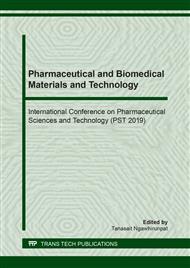p.202
p.209
p.215
p.221
p.227
p.233
p.240
p.246
p.252
Influence of Process Parameters on the Characteristics of Hydrophilic Drug-Loaded Microparticles through Double Emulsion Solvent Evaporation Technique
Abstract:
The purpose of this study was to investigate the influence of process parameters on the characteristics of microparticles using double emulsion solvent evaporation method for encapsulation of hydrophilic drug. Donepezil hydrochloride (DPH), a reversible cholinesterase inhibitor, was selected as a model hydrophilic drug. Prior to conducting an experiment, the target particle size of microparticles was set at approximately 200 μm. The investigated process parameters include pH of outer water phase, stirring time, polymer amount, and volume of outer water phase. The results showed that DPH-loaded microparticles was successfully prepared in two steps. In the first step, the primary emulsion was prepared by dissolving DPH in distilled water before emulsifying in dichloromethane (DCM) containing different amounts of poly(butylmethacrylate-co-2-dimethylaminoethyl-methacrylate-co-methyl-methacrylate) (PBM-DM-MM) using ultrasonic probe. In the second step, the primary emulsion was emulsified in polyvinyl alcohol (PVA) solution by overhead stirrer to prepare double emulsion. After solvent evaporation, the microparticles were collected by centrifugation and washed with distilled water. Based on the statistical analysis, stirring time, polymer amount and volume of outer water phase were the main significant parameters influencing particle size of microparticles.
Info:
Periodical:
Pages:
252-257
Citation:
Online since:
August 2019
Authors:
Keywords:
Price:
Сopyright:
© 2019 Trans Tech Publications Ltd. All Rights Reserved
Share:
Citation:


